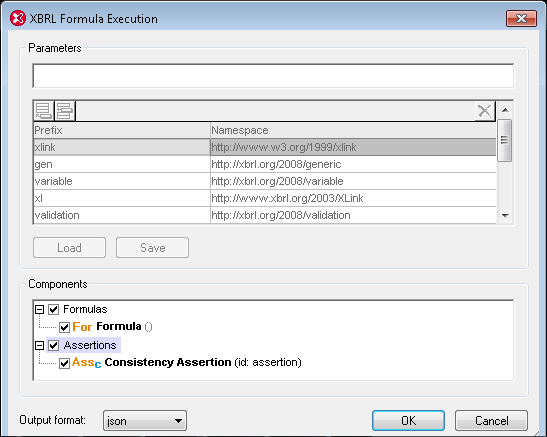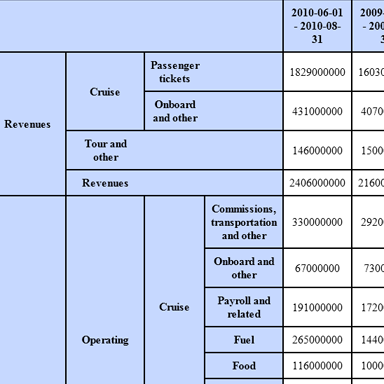New XBRL Tools for Compliance and Beyond
It can be hard to keep up with all the exciting developments in the XBRL space. Standards are constantly evolving to make compliance easier and deepen the benefits provided by XBRL for internal analysis and reporting. As a leader in XBRL development and validation, Altova is committed to supporting the latest standards, coupling strict conformance with high-performance, easy to use tools. With the latest product launch, Version 2014 Release 2, we’ve added some important enhancements, including significant increases in validation speeds, XBRL Table Linkbase support, and extended XBRL Formula tools. Below is a portion of an XBRL Table generated in XMLSpy, using XBRL Table Linkbase to render revenue calculations in new and productive ways:
Let’s take a look at the benefits of these new features for your XBRL implementation.
Increased XBRL Validation Speed
RaptorXML+XBRL Server was already the fastest XBRL validation processor available – and Version 2014 Release 2 provides substantial performance improvements. Validation speed increases are most significant – up to three times faster – on multicore servers taking advantage of parallel validation, making validation of large amounts of XBRL data faster than ever before.
XBRL Table Linkbase Tools
XBRL Table Linkbase is perhaps the most exciting of the many recent developments in the XBRL space. The Table Linkbase gives taxonomy authors the ability to easily define the structure of tables for presenting (and even editing) XBRL data. Sure, the presentation linkbase already lets you define some rules for rendering XBRL, but it only provides for the arrangement of facts in a simple hierarchy. XBRL Table Linkbase goes well beyond this, allowing you to access, combine, evaluate, and present multi-dimensional XBRL facts and relationships to suit just about any requirement.
By standardizing the ability to present XBRL data to suit the needs of all stakeholders, XBRL tables add value beyond meeting compliance requirements.
XBRL Table Linkbase validation is now supported by both RaptorXML and XMLSpy, and XMLSpy includes a new XBRL Table Linkbase editor, which you can see on a new tab in the XBRL Taxonomy Editor.

Here, it’s easy to add and define tables using graphical diagrams, context menus, and the Details entry helper window.
When an XBRL Table Linkbase is associated with an XBRL instance, it’s easy to render tables directly in XMLSpy by selecting the new Generate Table option from the XBRL menu. The image below is a snippet of an XBRL table generated in HTML, which presents financials from a well-known cruise ship company calculated in various ways, based on reported XBRL data.
 Learn more about XBRL Table Linkbase:
Learn more about XBRL Table Linkbase:
- Altova XBRL Table Linkbase page
- Table Linkbase Specification from XBRL International
New XBRL Formula Support
Like XBRL Table Linkbase, the XBRL Formula specification adds to functionality inherent in XBRL in a standardized, backwards compatible manner. XBRL Formula allows use of XPath to validate business rules and/or to calculate new XBRL facts based on reported XBRL data. XBRL Formula validation support was added to RaptorXML Server in Version 2014, along with an easy-to-use XBRL Formula editor in XMLSpy.
Release 2 of Version 2014 adds the ability to execute formula calculations and view the results directly in XMLSpy. When an XBRL instance document open in Text View or Grid View is associated with defined XBRL Formulas, you can select the new Execute Formula command in the XBRL menu to open the Execute Formula dialog box, add any required parameters, and select the formula(s) to be executed. Formulas are evaluated with data in the XBRL instance file, and the results are output in an XBRL instance file. The same dialog can be used to evaluate assertions, with output to XML or JSON.  Be sure to upgrade to Version 2014 Release 2 to get access to all this new functionality. If you’re new to Altova, you can download a free trial of any desktop developer or server software product, including XMLSpy and RaptorXML+XBRL Server.
Be sure to upgrade to Version 2014 Release 2 to get access to all this new functionality. If you’re new to Altova, you can download a free trial of any desktop developer or server software product, including XMLSpy and RaptorXML+XBRL Server.
And if you’re new to XBRL, check out our free, online XBRL training.

